Cold Smoked Salmon Recipe
If you are looking for an easy, versatile protein, look no further than cold smoked salmon. You’ll love this smoky, flavorful fish on toast, in salads, or just as-is!
Fellow salmon lovers will also like this aromatic cured salmon recipe, my salmon and asparagus foil packets, and this parmesan-crusted salmon casserole.
FAQs About This Smoked Salmon Recipe
Before we even get into this smoked salmon recipe, I want to address some of the most frequently asked questions about making (and eating!) this dish.
Are Smoked Salmon Slices Cooked?
There are two different methods of smoking salmon: hot and cold.
- Hot smoked salmon gets a wet brine, and then is smoked at, or above, 120°F.
- Cold smoked salmon is dry-cured in salt for several days to draw out moisture, then smoked at, or below, 80°F. The smoke cures the fish rather than cooks it, so it is considered raw.
This particular smoked salmon recipe is the cold kind. While it’s technically raw, the brine and the smoke will remove bacteria. This type of fish is safe to eat if prepared correctly. With that being said, experts recommend pregnant women and those with compromised immune systems enjoy hot smoked salmon rather than cold.
How to Eat This Smoked Salmon Recipe?
This delicate smoked salmon recipe is best enjoyed when it is not cooked into a casserole or dish. Instead, try these ideas:
- Enjoy it on top of a bagel with cream cheese
- Add it on the side of your scrambled eggs
- Serve it as an appetizer along with lemon wedges, veggies, and a homemade baguette
- Turn it into DIY sushi.
How Long Should I Smoke Salmon?
For cold smoked salmon, you will need to let it smoke for about 12-24 hours, depending on the thickness of the salmon fillet. As you can see, this isn’t a fast meal, but it’s mostly hands off and oh-so-worth it!
How to Make the Smoked Salmon: Tips and Tricks
Learning how to smoke salmon may seem complicated, but it is actually quite simple. Use these tips and tricks to get started, and you’ll be a pro in no time!
1. Choose the Right Salmon Fillet.
The type you are looking for ideally is a fish fillet with the skin on and the pin bones removed. Farm-raised salmon will yield a more fatty end product, while wild-caught salmon will give you a drier end result.
2. Mix the Sugar and Salt
Then cover the fillet with the mixture to draw out moisture, improve texture, and to make it safer to eat.
3. Get the Right Sawdust for smoking
You’ll want to get extra fine smoking chips for this type of cold smoking. Regular smoking chips or pallets are troublesome because they don’t produce consistent smoke as without continued fire input, the smoke tends to die out. Wetting smoking pallets to help them break down, then oven drying them produces the best smoking chips for consistent smoking.
4. Form a Pellicle
The pellicle is the tacky film on the outside of the salmon fillet created by letting it air dry. Start by rinsing off the salt from the salmon, and soaking it in cold water for 30 minutes to remove the extra salinity. Next, pat dry with a paper towel. Transfer to a cooling rack and leave in the fridge for at least 4 hours or up to 2 days to create the best surface for the smoke to adhere to when smoking.
Tip: another way to dry the fish is to hang the fish on hooks and set a fan at an angle that can blow dry both sides of the fish at the same time. A drying cage can also be a good option to give you the ability to dry lots of fish at once outdoors, with a fan set in front of it because the mesh of the cage will prevent critters from getting to the fish.
Drying with a fan also helps to draw out more moisture out of the fish, fastert han just drying the fish in the fridge, so this option is good for speeding up the process.
5. Smoke
Fill the smoke generator (I use this Smoke Generator, but any comparable product will work) with the dried out super fine sawdust. Make sure to scrape off the excess off the top so that the smoke doesn’t jump the wall. When learning how to smoke salmon, start the smoking by pointing a blow torch to the beginning of the spiral path and setting a tea candle underneath. The blow torch really seems to speed up the process.
Once smoking steadily, remove the tea candle, and set the smoke generator into the smoker (I use Little Chief smoker for cold smoking) or the inside of the grill. Add the salmon to the opposite side of the smoker and ice (if needed) and close the lid with the air vent completely open.
Use a probe thermometer to ensure that the inside of the smoking chamber does not go above 80F for cold-smoked salmon.
Leave to smoke for up to 24 hours, checking on the smoke generator for consistent smoke output, periodically.
6. Chill
You’ll do this once the salmon is done. There are a few ways to tell if it’s ready: the salmon is firmer to touch (not a lot of give when pressed), it will be translucent when sliced, and have the right smokiness (your preference).
Once your smoked salmon is ready, remove it from the smoker and chill. Then, slice and serve.
More Seafood Recipes:
Cold Smoker Recipe (Using a smoker)
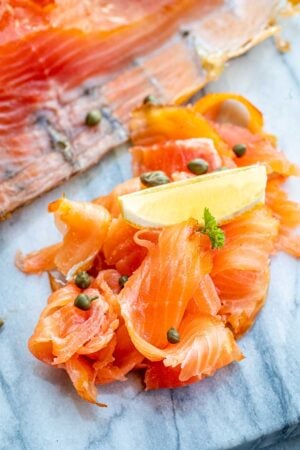
This cold smoked salmon is delicious on salads, on toast, or off the fork! Here's everything you need to know about how to smoke salmon.
Ingredients
Cold Smoked Salmon Ingredients
- 2-3 lb salmon fillet skin on
- 1 1/2 cups non-ionidized sald sea salt or kosher salt
- 1 1/2 cups brown sugar
Smoking Chips (sawdust)
- 4 cups smoking pallets 2 cups Alder and 2 cups Apple pallets
- 3 cups hot water
Instructions
Prepare the salmon for smoking:
-
Remove pin bones: Run fingers down the top of the salmon fillet and remove any pin bones with tweezers or pliers if you encounter any sharp ends.
-
Cure the salmon: In a bowl mix sugar and salt. Then in a rimmed baking dish the size of the salmon fillet lay half of the prepared mixture. Place the fillet skin side down on top of the mixture and cover with the other half of the sugar-salt mixture making sure to cover the fish completely. Cover the container with plastic wrap or foil and refrigerate for 24-48 hours, rotating the salmon fillet as needed to keep both sides submerged in the salt-sugar mixture. The cure will help to kill any bad bacteria and draw out moisture from the salmon fillet.
Alternatively, place the salmon with the salt mixture into a FoodSaver bag and vacuum seal it. This will allow the salmon fillet to be submerged in the salt/sugar mixture at all times. Rotate the bag as needed to keep both sides of the fillet covered in the cure.
-
Dry out the fish:
Remove the salmon from the cure and gently rinse. Then, soak in cold water for about 30-45 minutes to remove excess salinity. To see if the fish is salted to your liking or needs more soaking time, slice off a small piece from the fillet and taste it. Once it is at your desired salinity level move on to the next step.
Pat dry the salmon with a paper towel. Set a cooling rack on top of a baking sheet and place the fish on top, skin side down. Refrigerate uncovered in the coldest part of the fridge overnight (minimum 4 hours recommended) or up to 24 hours to form a dry outer layer to help the smoke adhere otherwise known as the pellicle.
Pro Tip: A mesh drying cage can also be a good option to give you the ability to dry lots of fish at once outdoors with a fan set in front of it. The fan will help to dry the fish faster. The mesh material will allow for airflow from the fan to go around the fish, while not letting any critters in.
Drying with a fan also helps to draw out more moisture out of the fish than just drying the fish in the fridge, so this option is good for speeding up the process.
Meanwhile, prepare the smoking sawdust for the smoker.
-
Preheat oven to 200F with the baking rack in the middle. In a large bowl combine 4 cups of smoking pellets (Apple and Alder pellets in 1:1 ratio is best) and 3 cups of hot water. Allow the water to be completely absorbed, tossing and breaking the pellet as needed to help absorption.
Then, transfer to a rimmed baking sheet. Spread the sawdust into an even layer and dry in the oven for about 4 hours, stirring occasionally until completely dry.
-
Generate the cold smoke:
-
Once completely dry, fill the smoke generator with the dried saw dust. Use the edge of a knife or ruler to scrape off excess saw dust. Transfer the filled smoke generator to the smoker or the grill. Any large, enclosed, nonflamable space like the grill or the smoker will work for this.
-
Set a lit tea candle at the beginning of the spiraling trail. This will start the smoking process of the saw dust. To speed up the process you can use a blow torch at the same time and point the flame towards the top of the saw dust at the beginning of the spiral. Once the tea light goes out (about 15 minutes later), and the saw dust is consistency producing smoke/smoldering add the salmon fillet to the rack about 12 inches away from the smoke generator. Close the lid of the smoker and open the vent to help the oxygen get inside the smoker.
-
Keep it cool: The inside of the smoker should not rise higher than 80F. A probe thermometer is a good tool to help you keep it in check (Note 1). If it's warmer outside, fill a baking dish with ice and set it about 1-2 inches below the fish. Keep replacing the dish with ice throughout smoking to keep the temperature inside the smoker down.
-
Smoke the salmon: Let the fish smoke for around 12 - 24 hours (more or less depending on the thickness of the salmon), checking occasionally to make sure that the smoke is still being produced. The salmon is properly smoked if it is darker in color, firm with not a lot of give when pressed on and somewhat translucent. You can cut a small piece and taste it and decide if it's smoked to your liking.
-
Chill: Once the smoked salmon is finished smoking refrigerate it for several hours until it is well chilled. Then, slice and serve.
Recipe Notes
Note 1:
I use this thermometer. Having the probe part inserted in the fillet and by the smoker while keeping the other one inside the house in my view allows me to monitor the temperature from the inside without having to constantly run to the smoker and check on it. It's an investment, but very worth the money.
Thank you for following me on Instagram, Facebook & Pinterest!
Hashtag your photos #LetTheBakingBeginBlog so I can see your creations and for a chance to be featured!

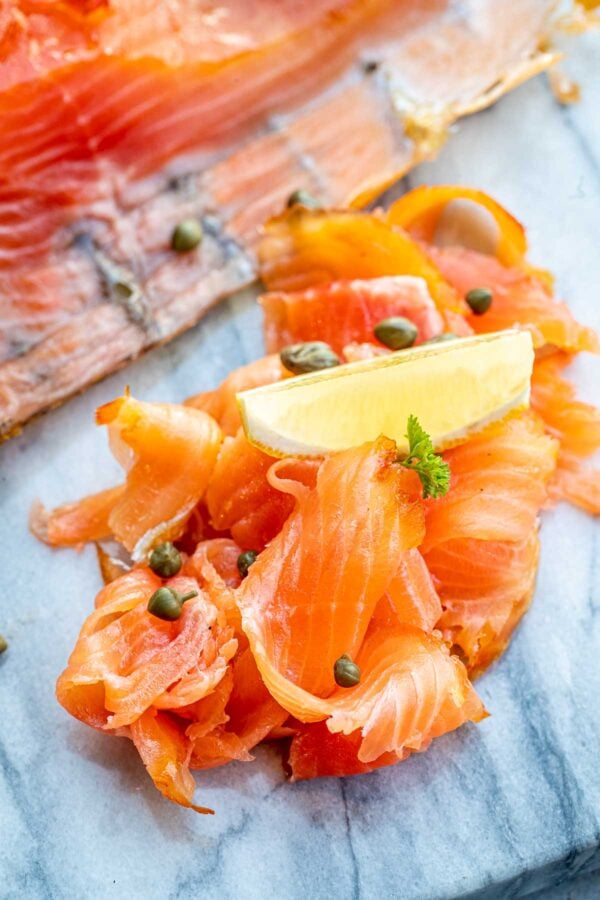
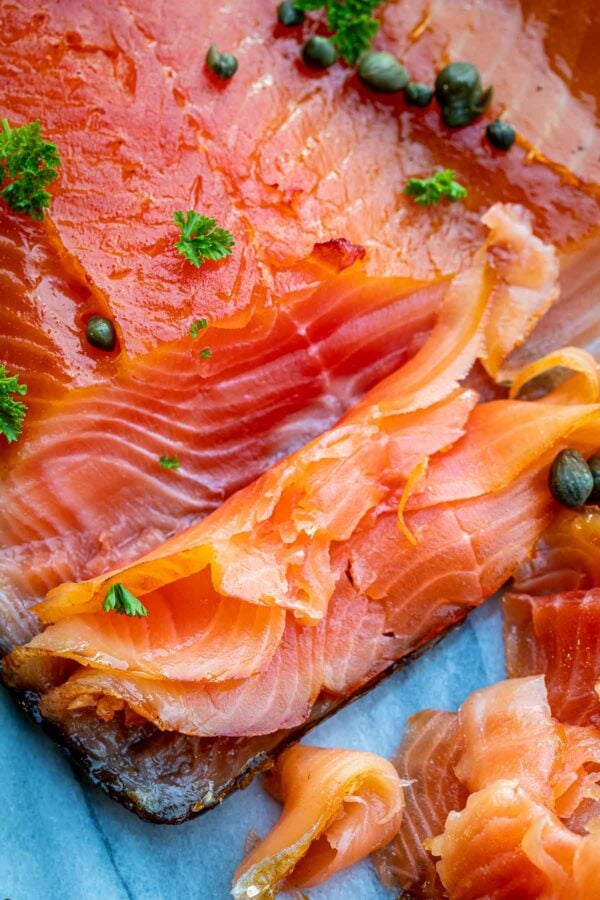
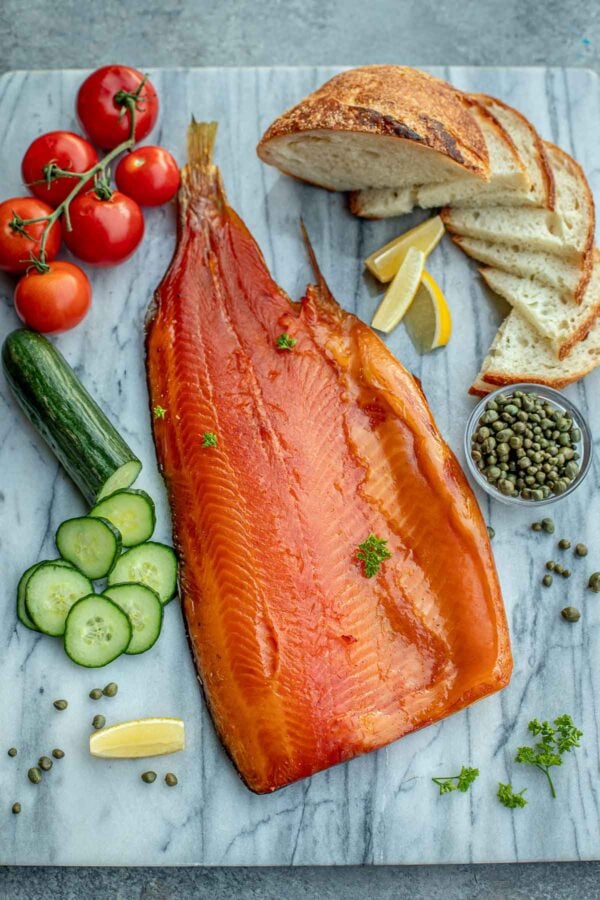
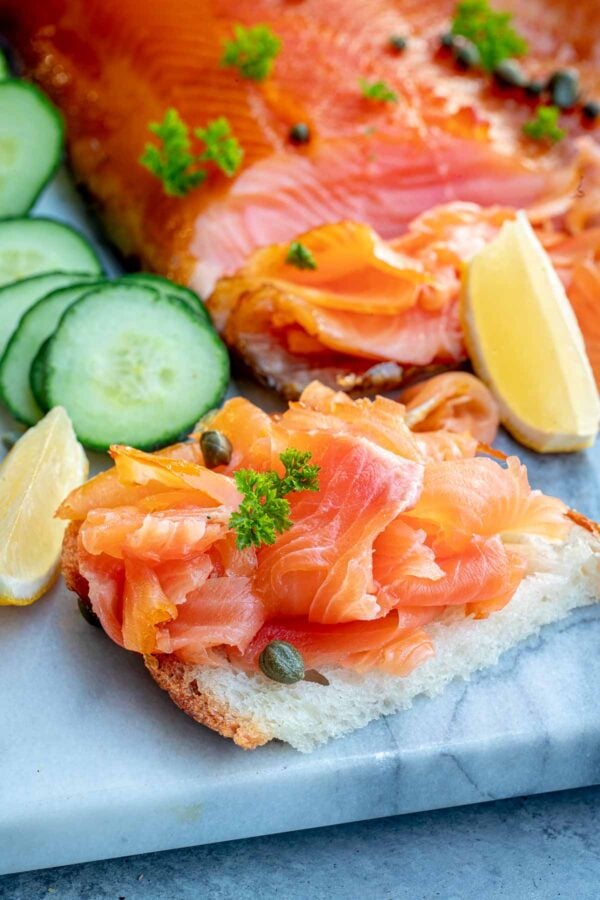
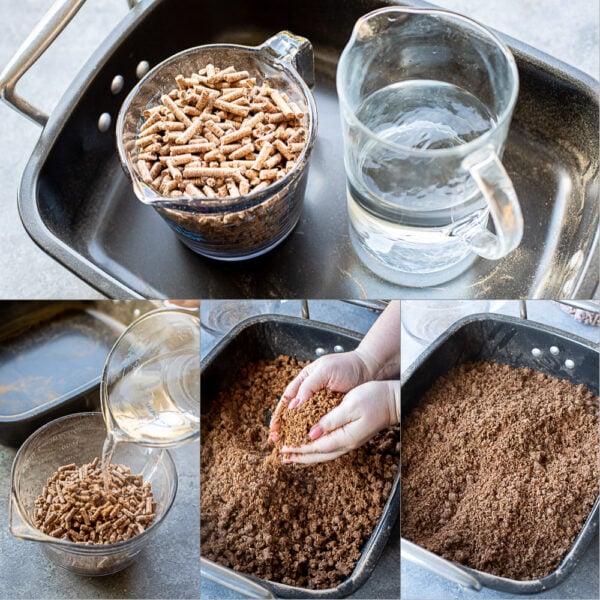
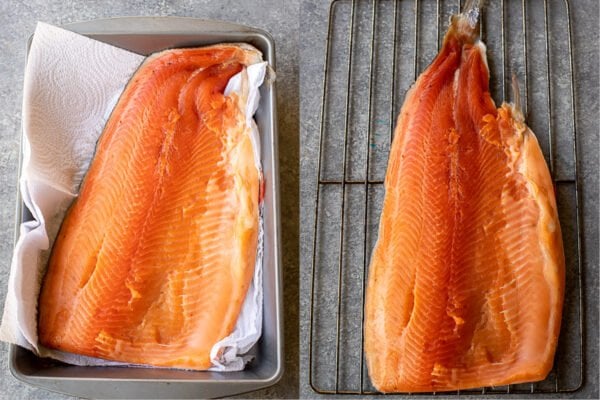
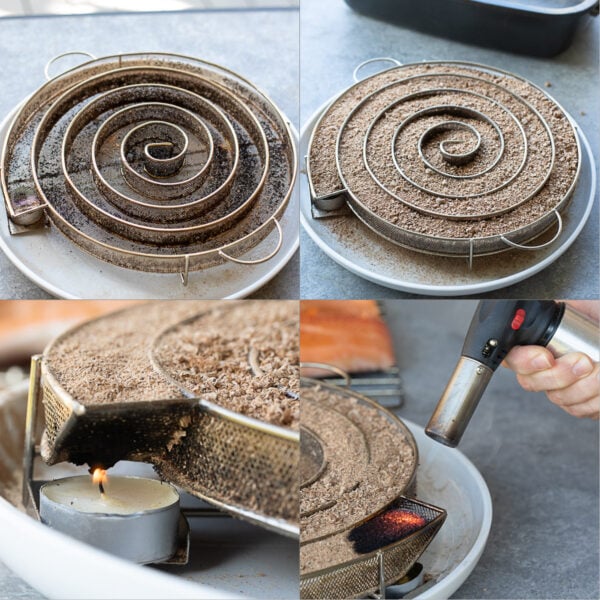
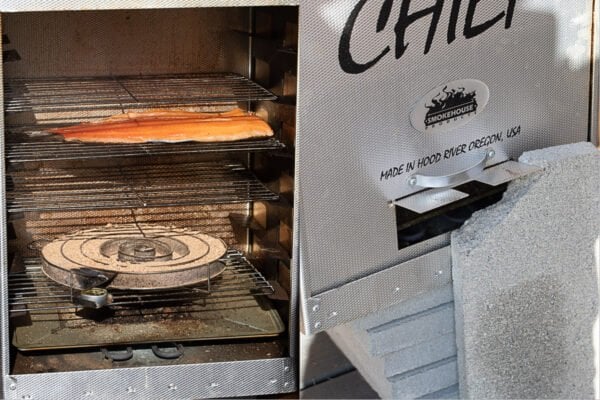
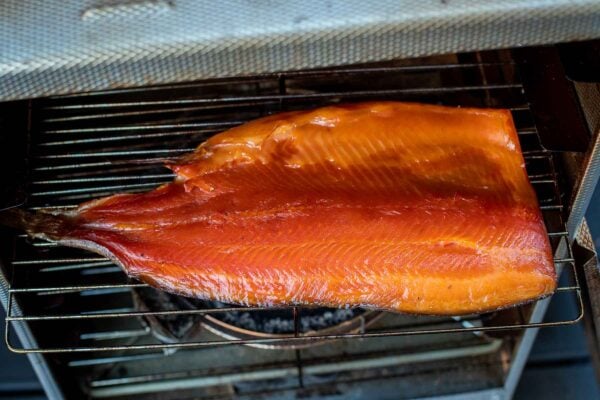



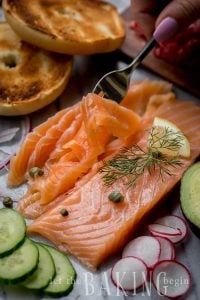
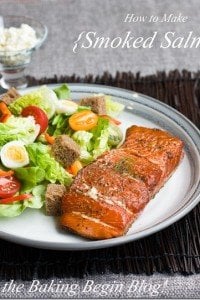


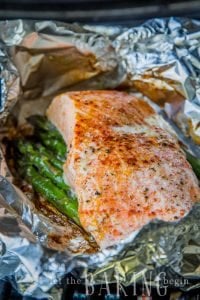

A small detail that could save folks a lot of trouble: per the US FDA, salt cure and/or smoke will not kill all or even most parasites within meat. I freeze my salmon per FDA guidelines before eating it raw (sushi or lox).
How long will the finished product stay good? And what would be the best way to store it, in the refrigerator?
I have a smoker but the lowest it goes is is 165 F I saw on the one you have that’s also the case how do you keep the heat at 80? Or you don’t turn the smoker on just the spirile smoke thing?
I’m sorry this just looks delicious and I would love to make it.
The smoker is only used as a container to keep the fish in. It is not to be turned on. The smoke is produced from the spiral loaded with the broken up pellets. Does this make sense?
I don’t eat meat now but I loved seeing this recipe! It brought back memories of eating bagels with cream cheese and lox on Sat mornings at my Bubby’s house! Thank you for sharing. You have a beautiful family!
Great idea! I wish you could do a time lapse of the smoking process. If this really works, its a brilliant way to cold smoke without a special cold-smoking contraption.
I’m fascinated!
Hi Gen, well, you still need the smoke generator, but it definitely less expensive than an actual smoker, and take less space too. So as long as you have a grill or something similar, you can get the smoker generator and you’re good to go.